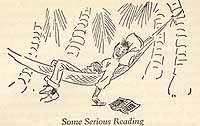

- Grand Bahama in 1887 from L. D. Powles The Land of the Pink Pearl or Recollections of Life in the Bahamas.
- Grand Bahama in 1891 from Stark's History and Guide to the Bahama Islands.
- Grand Bahama in 1917 from Amelia Defries In a Forgotten Colony
- Grand Bahama in 1924 from The Tribune Handbook
- Grand Bahama in 1926 from Mary Mosley The Bahamas Handbook.
- Grand Bahama in 1934 from Maj. H. M. Bell Bahamas: Isles of June
- Grand Bahama in 1931 from Nassau and the Treasure Islands of the Bahamas
- Grand Bahama in 1967 Moral Panic, Gambling. and the Good Life
Boom Town in the Bahamas
Pamela Fiori Holiday, Feb. 1970
p. 56
Twenty “air” minutes east of Palm Beach, the upper crust’s unruffled playland, is a six-year-old, 214 acre prodigy of a resort on a British-owned island. Investors, realtors, and public relations men have zealously acclaimed it as the New World Riviera. Their optimism may be more perception that fantasy, for Freeport, on the island of Grand Bahama, is undergoing the most astounding growth in the tourist history of the Atlantic and Caribbean islands.
Sixteen years ago, the most impressive things to be said about Grand Bahama, the northern-most and fourth-largest in the Commonwealth of the Bahamas, were that it had a population of 4,000, a lumber camp in existence since 1929, and acres of unattractive yellow pine woods.
Today, tourism is Freeport’s “single crop,” and in 1968, it yielded $125,000,000. It is also the only resort that boasts the largest gambling casino in the Western Hemisphere, the longest landing strip in the Bahamas and the most enormous hotel in the Caribbean area.
Seventy-five percent of the credit for Freeport’s success goes to Virginia-born financier Wallace Groves. Stepping away from what might have been a Guaguinesque existence on Whale Cay, his private island retreat, Groves announced his intentions some years ago of turning the vacant land he owned on Grand Bahama Island into a customs-free (hence “free port”) industrial area. With the aid of several American and English investors, Groves formed the Grand Bahama Port Authority, Ltd., and also convinced the government to pass a remarkable piece of legislation. Its provisions allowed pioneering with a new twist: virtually no taxation until 1990. In return, the Port Authority promised to develop tourism in the beach area of Freeport-Lucaya.
But it was not until 1964 that Freeport seemed to be in the “get ready” stance for competition with Jamaica, Puerto Rico and the Virgin Islands. That year the Lucayan Beach Hotel and the adjacent Monte Carlo Casino opened. The race was on, and Bahamian Boomtown was born. /
Today, most of the scrub palm and coral debris has been bulldozed away and replaced by thirteen resort hotels, four eighteen-hole golf courses, three country clubs, two gambling casinos, more than thirty restaurants, luxury apartments and cooperatives, a movie colony and a $3,000,000 shopping complex featuring international food and merchandise.
Freeport is a potpourri resort, and one visit to the intersection near Sunrise Mall can verify it; the King’s Inn Hotel is Miami Beach; the Pub on the Mall is Olde London (fish and chips and Watney’s Red Barrel Ale); the ersatz white mosque housing El Casino – endearingly described in a brochure as a “Taj Mahal-like shrine to Lady Luck” – is India.
Every year the tourist population climbs dramatically: 26.000 in 1963; 440,000 in 1968; and over a 60 percent increase in 1969. But even while increasing in number, tourism is shifting in kind. Last year Freeport was a haven for all-inclusive group tours. Scores of retired couples from Pittsburg and Cleveland, and singles club members from Queens would emerge from charter planes as others boarded. They still come, but so, too, did Yoko Ono and John Lennon, Mia Farrow (one scene from John and Mary was shot at the Lucayan Beach Hotel) and ex-president Lyndon B. Johnson. In April semester-break expatriates from Fort Lauderdale and Daytona Beach invaded the island; in June, Warner Brothers held a film festival.
The year hints at being even better, and Samuel Taylor Coleridge may have unwittingly inspired part of it. A $5,000,000 yacht and tennis club called Xanadu hopes to lure the much sought after, if often fickle, affection of international society. Membership is open to a “select group” which is enough to up the tourist rate considerably. A discotheque with a Tiffany glass dance floor, ninety-six hotel suites, seven Mediterranean-styled villas (each with private swimming pool), and an executive jet ready to whisk members to Freeport from Gstaad and Acapulco are a few of the fringe benefits.
Seventy-six miles away, the in-season Palm Beachites may simply shrug their shoulders and continue to dance at night and anoint themselves with suntan lotion during the day. But meanwhile, in Freeport, as the temperature rises along with the condominiums, gambling stakes and life-style, the tag “New World Riviera” begins to take hold.
